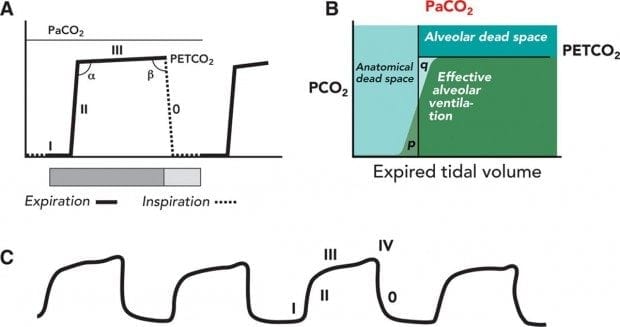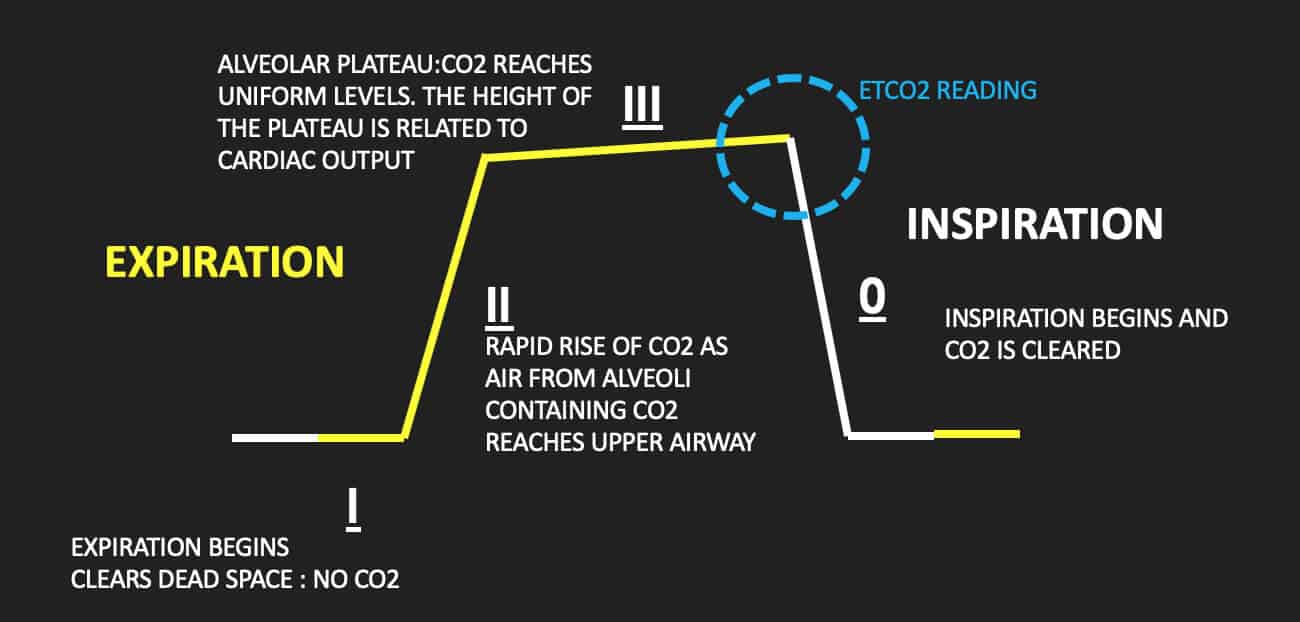normal end tidal co2 pediatric
The median ETCO 2 value was 32 mmHg IQR 27 38 mmHg range 18-80 mmHg. Prior to the reading the monitor was left in place for approximately 5 minutes at which time an arterial blood gas value was obtained.

The Critical Role Of Capnography Airway Management Paramedic School Respiratory Care
Never-theless a plateau may be absent especially in small children with a relatively high respiratory rate.

. When compared with end-tidal carbon dioxide ET-CO2 monitoring techniques TC-CO2 monitoring has been shown to be equally as accurate in patients with normal respiratory function and more accurate in. These lung-protective strategies recruit atelactetic areas while preventing over distention of normal lung parenchyma. This study was designed to determine whether end-tidal carbon dioxide ETCO2 values obtained by noninvasive oralnasal cannula circuit with side-stream capnometry correlate reliably with capillary PCO2 CapCO2 in a pediatric population without cardiopulmonary problems.
TC-CO2 monitoring can now be used in infants children and even adults. Capnography provides valuable timely information aboutthefunctionofboththecardiovascularandrespiratorysystems. 1 Division of Pediatric Anesthesiology Departments of Anesthesiology.
In the pediatric age range abnormalities include oxygen desaturation under 92 more than one obstructive apnea per hour and elevations of ET CO 2 measurements of more than 50 mm Hg for more than 9 of sleep time or a peak level of greater than 53 mm Hg. End-tidal carbon dioxide monitoring or capnography End-tidal carbon dioxide EtCO 2 monitoring is an attractive method as it is non-invasive portable and relatively inexpensive. The next inhalation may precede the purely alveolar phase of exhalation that is.
Each patient was monitored until a reliable 5-minute ETCO2 waveform was obtained. Note that this gradient may be considerably higher in situations where there is an increase in dead space. Polysomnographic normal standards differ between children and adults.
Jindal et al have also stated that decreased pulmonary-to-systemic shunt ratio increases arterial to end-tidal carbon-dioxide difference secondary to. During sedation capnography is often used to assess the breath-to-breath analysis of carbon dioxide concentration. Accurate measurement of delivered tidal volumes in infants and children is essential during mechanical ventilation.
End-tidal CO 2 monitoring is the single most useful method in confirming endotracheal tube position. These values are consistent across all age groups. Measuring Pediatric Tidal Volumes.
An accurate determination of the tidal volume Vt delivered to a patients lungs is essential when mechanically ventilating infants and children. End-tidal CO 2 et CO 2 monitoring is not a new modality in the pediatric emergency department PED and emergency department. The technique has been End-tidal carbon dioxide monitoring in neonates Carbon dioxide monitoring is vital in the management of ventilated newborn babies.
Listed in this appendix are pediatric normal ranges for some of the more common hematology and chemistry tests along with the references from which they were obtained. Normal ETCO2 is 35-45 mm HG and a normal waveform is rectangular shaped. However et CO 2 may be underused in the PED setting.
For a person with normal lungs the difference between end tidal and Paco2 can vary between 5-8mmHg depending on the book your reading. As stated before end tidal is slightly different. The PaCO 2 value varied from 19 to 86 mmHg.
With a normal match of alveolar ventilation and perfusion this gradient is roughly 2 to 5 mmHg where the arterial carbon dioxide is greater than the exhaled carbon dioxide. It should be noted that a plateau phase in the carbon dioxide waveform is mandatory. Feb 7 2007 Clinical Critical Care.
It is the standard of care during certain procedures such as intubations and sedations and can be used in variety of clinical situations. 1-3 Clinicians may however observe a widened or increased gradient. The end-tidal carbon dioxide level petco2 corresponds with the Paco2.
Forty-six of 96 48 95 confidence interval CI 38 58 patients had abnormal ETCO 2 values including 37 39 95 CI 29 49 with low ETCO 2 levels and. So the short answer is you are right about the ranges 35-45 but that is for actual PaCo2 drawn from an ABG. Tidal Volume - 8-10mlkg with a goal to get to 6-8mlkg.
The mean difference between the transcutaneous and arterial CO 2 value was 194 mmHg with a 95 confidence interval of 012 to 407 mmHg. In normal healthy lungs the match of arterial carbon dioxide and exhaled CO 2 is closely correlated. Under normal conditions the end tidal CO2 is usually slightly less than the PaCO2 with a normal difference of 25 mmHg.
If leak present around ET tube set initial tidal volume to 10-12mlkg. End-tidal carbon dioxide CO 2 monitoring is useful in the prehospital setting emergency department intensive care unit and operating room. We are looking at the impact of severity of lung disease on correlation of end-tidal and arterial carbon-dioxide levels irrespective of underlying etiology that may be cardiac or noncardiac.

Waveform Capnography In The Intubated Patient Emcrit Project

Capnography Nursing Procedures Icu Nursing Nursing School Studying

Waveform Capnography In The Intubated Patient Emcrit Project

Capnography Waveform Interpretation Litfl Ccc Equipment

Capnography In The Pediatric Emergency Department Clinical Applications

Pdf Applications Of End Tidal Carbon Dioxide Etco2 Monitoring In Emergency Department A Narrative Review Semantic Scholar

Basic Waveform Capnography As A Continuous Monitoring Tool During Mechanical Ventilation

End Tidal Carbon Dioxide Recording Of Ventilated Children In Picu N 535 Download Scientific Diagram

The Impact Of Ventilation Rate On End Tidal Carbon Dioxide Level During Manual Cardiopulmonary Resuscitation Resuscitation

A Systematic Approach To Capnography Waveforms Jems Ems Emergency Medical Services Training Paramedic Emt News

Mcat Memoranda Capnography Which Measures The Level Of Carbon

End Tidal Carbon Dioxide Recording Of Ventilated Children In Picu N 535 Download Scientific Diagram
Riding The Wave Of Capnography Understanding Etco2 Vetbloom Blog

Pdf Capnography In The Pediatric Emergency Department Clinical Applications Semantic Scholar

Evidence Supports Using End Tidal Carbon Dioxide To Detect Prehospital Sepsis Jems Ems Emergency Medical Services Training Paramedic Emt News

Continuous Capnography In Pediatric Intensive Care Semantic Scholar

Normal And Abnormal Capnography Waveforms Infographic Capnoacademy Capnoacademy
